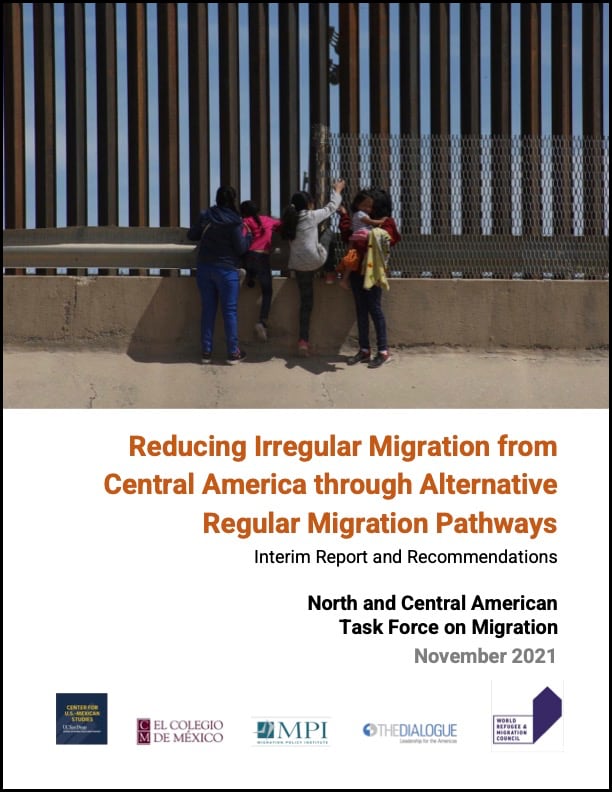Interim Report and Recommendations: North and Central American Task Force on Migration

Developing Alternative Regular Migration Pathways
While Task Force reports have focused on addressing the drivers of Central American — corruption, weak rule of law, violence, poverty, inequality, environmental hazards — this report considers alternative pathways for migration from Northern Central America.
The short answer to the question of why so many Central Americans are setting off on dangerous irregular migration journeys is stunningly simple: because there is virtually no way that they can move through regular, legal, safe channels. This is true for those seeking better economic opportunities, for those fleeing persecution and violence, and for those who leave their countries because of a combination of economic, political, and environmental risks. This is not a new issue; researchers and advocates in North and Central America have long advocated for development of alternative pathways (e.g. Selee et al 2021; Newland and Riester 2018; Hooper 2019). But given highly politicized responses to Central America it is more urgent than ever. Without alternative migration pathways, efforts to protect Central Americans and to manage borders will not succeed. Developing safe, legal migration channels would eliminate some of the negative consequences of irregular migration: extortion of migrants by unscrupulous smugglers, the suffering of separated families and human rights violations across the board.
Existing programs for temporary labor migration were mainly developed decades ago in a very different context and do not take into consideration the current conditions in Central America. In particular, demographic trends in both North and Central America are moving in different directions. In the US, the number of people over the age of 65 is expected to double in the next twenty years; the number of those over 85 will quadruple. Meanwhile, the number of workers who will share the cost of social security will plummet. (Urban Institute 2021). Population growth in Canada is due mainly to immigration; indeed while one person in five in Canada is an immigrant, the corresponding figure for the US is one in eight (INED 2021). And, as a recent Economist article summarized, “Mexico is aging fast,” with a falling birth rate, increasing life expectancy and low rates of immigration. The proportion of Mexico’s population under 20 years peaked in 2010 (Economist 2021). At the same time in Central America, the population of young people, aged 15-29 has surged 51 percent since 2000 compared to an increase of 16 percent in the US. Presently 30 percent of the population in Guatemala and Honduras and 28 percent in El Salvador are between 15 and 29; almost a third of young people in these three countries are not employed or in school or training programs (Spanos et al 2021). At a time when Canada and the US need young workers, Central Ameica has many more young people than jobs. Yet existing bilateral labor migration programs were developed when conditions were very different.
If regional labor migration systems are outdated, the system for protecting refugees from Central America is broken: they are not protected in their home countries, in transit through Mexico, or at the US-Mexico border. Many, perhaps most, of the Central Americans encountered at the US border in 2021 do not meet the strict criteria for refugees as enshrined in US and international refugee law (although many, perhaps most of them would meet the criteria in the 1984 Cartagena Declaration (UNHCR 1984). But there is simply no other way for them to enter the US, so they turn to the over-burdened asylum system and are often penalized for irregular entry. And yet, the drafters of the 1951 Refugee Convention recognized that people fleeing persecution may have no choice but to use irregular means to enter another country to ask for protection. Irregular entry should not be held against them – after all, asking for asylum is a basic human right. And few would blame Jews escaping Nazi Germany from using fake passports or paying smugglers to help them escape.
As Michael Clemens points out, from January through July 2021, 478,000 citizens of Northern Central America were apprehended at the US border. In that same seven months, Northern Central American citizens were given just 8,641 work visas and 1,520 grants of asylum by the United States. This meant that only one in 50 people apprehended at the border had any lawful channel for entering the US. For the other 49, there were no visas; there were no grants of asylum. They had only two alternatives: to migrate unlawfully, or simply to endure the conditions that drove them to this desperate and dangerous act. Even including other countries in the region would not much alter this picture. The total lawful channels for Northern Central America citizens to Canada, Mexico, or the United States amounted to about 3.5 for every 50 people apprehended at the US border.
In looking at possibilities for alternative regular migration pathways, we have followed convention and divided the possibilities into those for labor migration and for protection. But the pathways are connected in several ways. First, the motivations for migration are often mixed – often people move because they cannot survive at home: they cannot find jobs, social safety nets are non-existent, they are extorted by criminal gangs, drought has destroyed their crops or hurricanes have decimated their homes. As Abuelafia et al (2018) found, 40 percent of migrants from northern Central America cite fear of death from generalized violence in the region as the reason for their migration and 40 percent state that their economic opportunities in their home country do not allow basic sustenance for their families. Economic deprivation and fear of death are not separate drivers of migration: deprivation exacerbates the effect of violence, and vice versa (Clemens 2021a; Bermeo and Leblang2021; Ibáñez et al 2021). But the lack of legal migration pathways means that people are asking for asylum because there is no other possibility for entering the US. Developing more legal migration pathways is likely to reduce pressure on the asylum system. If there were safe, regular ways to enter the US, there would be less irregular migration.
It may seem crazy to talk about expanding regular migration pathways at a time when the pressure to close borders in the region is growing. But for several reasons, this is an opportune moment to press forward with this idea. First, obviously securitization of the border, the Migration Protection Protocol, and other restrictive measures are not working. Secondly, the lack of workers in the US at this particular moment in time would favor finding ways of increasing labor migration – a move which has been central to Canada’s immigration policy in recent years as well. Thirdly, the pressures of responding to the Afghan refugee situation in the US and Canada are leading to discussions of new protection pathways, such as private refugee sponsorship and in-country refugee processing, making this an opportune time to consider bold new ideas for dealing with migration from Central America. Fourthly, the time seems right to strengthen regional approaches to migration in Central America. Canada currently chairs the MIRPS Support Platform (Comprehensive Regional Protection and Solutions Framework to Address Forced Displacement in Central America) and will be followed by the US as chair – this is an opportunity for coordinated regional leadership of an important existing regional mechanism. Upon assuming the chairmanship of the UN Security Council, Mexican President Andrés Manuel López Obrador called for a new global fund to address poverty, perhaps signalling an increased commitment to multilateral approaches to addressing root causes. It is also time to consider – as the Task Force spelled in its report on out Regional Co-Responsibility – a new regional mechanism built on the model of the Arctic Council where regional strategies for migration are agreed and implemented.
This report is largely based on Task Force research papers prepared by Michael A. Clemens (Pathways for Labor Migration from Northern Central America: Five Difficult but Necessary Proposals) and Jennifer Bond (Alternative Protection Pathways in the Americas). The paper also benefited from a presentation by Jayne Fleming on the work of Lamp Lifeboat Ladder.
Le Groupe de travail sur la migration en Amérique du Nord et centrale is a non-governmental forum of academics, civil society and business leaders, and former policymakers in dialogue with current government officials created to facilitate a broadly driven solution dialogue among the countries involved in the crisis of migration and forced displacement in the region. Initiated by the World Refugee & Migration Council with the Center for U.S.-Mexican Studies, El Colegio de México, the Migration Policy Institute and the Inter-American Dialogue, the task force will issue concrete recommendations for collective, regional action based on evidentiary research to promote responsibility sharing across North and Central America.

